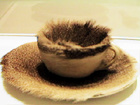 At left is an album cover: David Meltzer's jazz poems, 1958.
At left is an album cover: David Meltzer's jazz poems, 1958.Meltzer published The Clown in 1960. It was issued by the Semina press. Jed Birmingham on REALITYSTUDIO.org has written about the Semina Circle and Meltzer, thus:
This mini-archive sat in my bookshelf for a couple of years untouched until January of this year when I purchased Wallace Berman and the Semina Circle. This book accompanied an exhibit relating to the literature and art surrounding Berman until his untimely death in 1976. This exhibit is currently touring the West Coast and will make its way to New York City (New York University to be exact) in January 2007. A complete run of Semina Magazine represents the Holy Grail for me as a collector. An early fragment of Naked Lunch (Pantapon Rose) appeared in Semina 4. As I have mentioned before, Semina is the epitome of the little magazine as art object. David Meltzer appeared in Semina as well. In fact, the entire issue of Semina 6 features Meltzer’s The Clown.
Unlike Burroughs, Meltzer was an intimate member of the Berman Circle. He published a few books including Luna with Black Sparrow. In the late 1960s, he wrote a series of avant garde pornographic novels for Essex House. At the same time, he fronted the psychedelic band Serpent Power. In 2004, Meltzer published Beat Thing. He also edited two collections of valuable interviews entitled San Francisco Poets and San Francisco Beat. A collection of Meltzer’s papers are at Washington University.

 Is '60 the moment when the end of the end of the Old Left had been reached and the New Left began to emerge? Is it the final ascendancy, in certain scenes at least, of poetic postmodernity? Surely the publication of Donald Allen's The New American Poetry that year suggests this, but then again--once again--we look back on "New" here and see continuity. The rhetoric of the Kennedy-Nixon contest made much less of a dent than everyone (at the time as well as since) claimed, so one wonders why were such great claims made?
Is '60 the moment when the end of the end of the Old Left had been reached and the New Left began to emerge? Is it the final ascendancy, in certain scenes at least, of poetic postmodernity? Surely the publication of Donald Allen's The New American Poetry that year suggests this, but then again--once again--we look back on "New" here and see continuity. The rhetoric of the Kennedy-Nixon contest made much less of a dent than everyone (at the time as well as since) claimed, so one wonders why were such great claims made?  Had we come to expect "1960" to be truly ubiquitously modern in a way that the 1950s really were not--not quite? And what specifically does "modern" mean in the Kennedyesque talk then and now about the torch being passed to a new generation, etc.? The First Lady really meant "modernist" when Camelotians said "modern." What about the others across the new young cultural leadership? I've been surprised by how frequently the
Had we come to expect "1960" to be truly ubiquitously modern in a way that the 1950s really were not--not quite? And what specifically does "modern" mean in the Kennedyesque talk then and now about the torch being passed to a new generation, etc.? The First Lady really meant "modernist" when Camelotians said "modern." What about the others across the new young cultural leadership? I've been surprised by how frequently the  "Beat movement" was covered in 1960 in the mainstream press. I was expecting a fair measure but I've found tonnage. 1960 was the year when the figure of the beat was beginning to find acceptance, although still 80% of these stories are mocking, rebels-without-cause condescension. For anyone whose analysis made an impact nationally, do these antipolitical adolescents count as part of the "new young cultural leadership"? No, but rather than the two being opposites, they fall along a Continuum of the New American. Now that's a change for '60.
"Beat movement" was covered in 1960 in the mainstream press. I was expecting a fair measure but I've found tonnage. 1960 was the year when the figure of the beat was beginning to find acceptance, although still 80% of these stories are mocking, rebels-without-cause condescension. For anyone whose analysis made an impact nationally, do these antipolitical adolescents count as part of the "new young cultural leadership"? No, but rather than the two being opposites, they fall along a Continuum of the New American. Now that's a change for '60.







